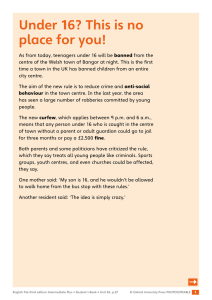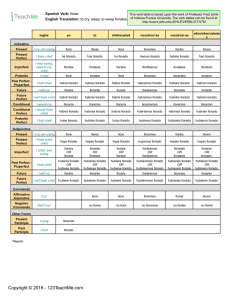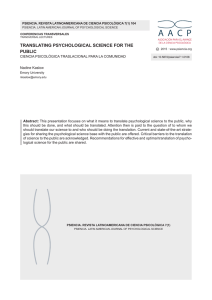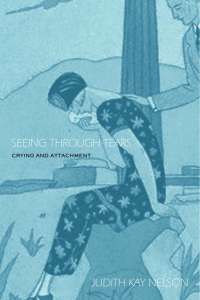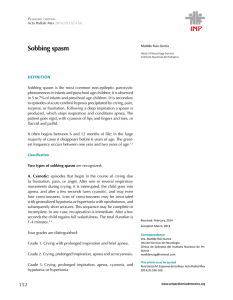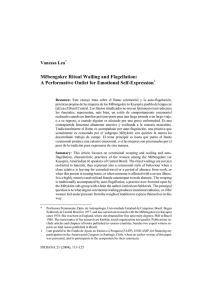Tilburg University The psychological context of crying episodes
Anuncio
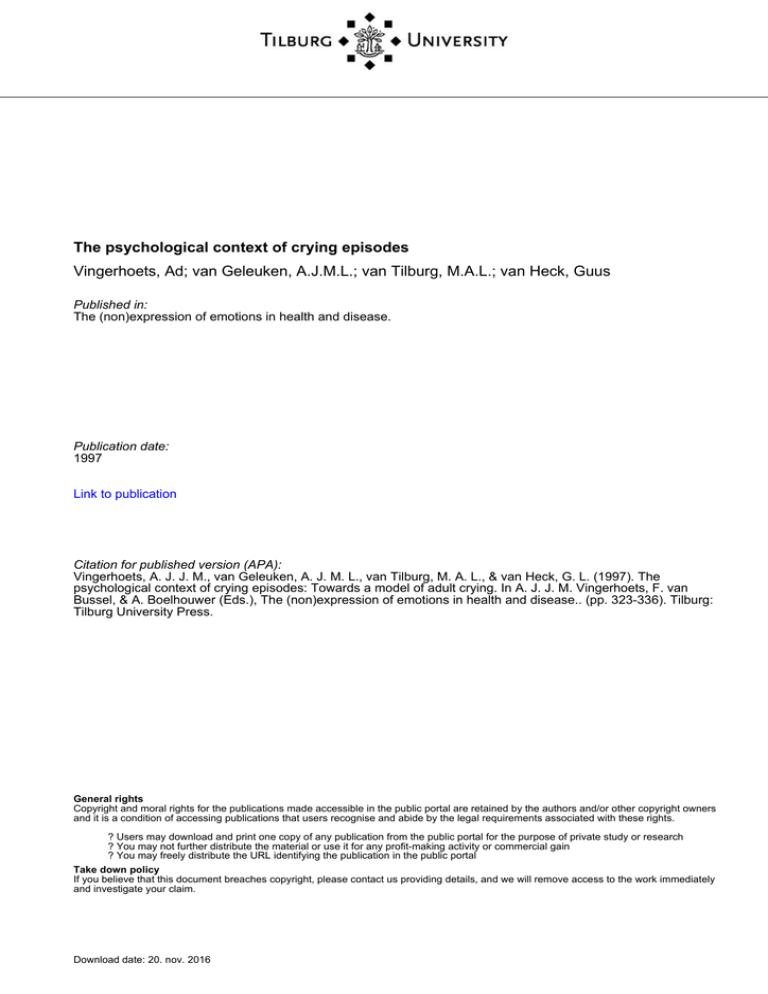
Tilburg University The psychological context of crying episodes Vingerhoets, Ad; van Geleuken, A.J.M.L.; van Tilburg, M.A.L.; van Heck, Guus Published in: The (non)expression of emotions in health and disease. Publication date: 1997 Link to publication Citation for published version (APA): Vingerhoets, A. J. J. M., van Geleuken, A. J. M. L., van Tilburg, M. A. L., & van Heck, G. L. (1997). The psychological context of crying episodes: Towards a model of adult crying. In A. J. J. M. Vingerhoets, F. van Bussel, & A. Boelhouwer (Eds.), The (non)expression of emotions in health and disease.. (pp. 323-336). Tilburg: Tilburg University Press. General rights Copyright and moral rights for the publications made accessible in the public portal are retained by the authors and/or other copyright owners and it is a condition of accessing publications that users recognise and abide by the legal requirements associated with these rights. ? Users may download and print one copy of any publication from the public portal for the purpose of private study or research ? You may not further distribute the material or use it for any profit-making activity or commercial gain ? You may freely distribute the URL identifying the publication in the public portal Take down policy If you believe that this document breaches copyright, please contact us providing details, and we will remove access to the work immediately and investigate your claim. Download date: 20. nov. 2016 27 The Psychological Context of Crying: Towards a Model of Adult Crying Ad J.J.M. Vingerhoets, Aly J.M.L. van Geleuken, Miranda A.L. van Tilburg, and Guus L. van Heck Introduction Crying is a typically human emotional expression that, unfortunately, has received little attention from behavioral scientists (cf. Bindra, 1972; Frey, 1985; Kottler, 1996; Lazarus, 1991; Vingerhoets, Cornelius, Van Heck, & Becht, submitted). Although there are a considerable number of theories and hypotheses on the nature and function of crying, these have until now hardly resulted in systematic research on this phenomenon. Concerning the functions of crying, Frey (1985) explicitly emphasizes the role of increased levels of stress hormones in the blood. He points to the active secretion of these substances, considering shedding tears as a way to restore homeostasis. Koestler (1964), in contrast, stresses the lack of appropriate responses in (positive and negative) emotional situations. Vingerhoets, Cornelius, Van Heck (submitted) wonder whether crying may be considered to be a kind of displacement activity, such as nail biting and leg swinging, all emotion-focused behavioral coping responses, meant to release tension (see also Steptoe, 1991). Another theory, put forward by Efran and Spangler (1979) (see also Labott & Martin, 1988), states that adults cry during a "recovery" phase following a period of arousal. Depending on the nature of the perturbation that elicits the arousal, the first phase is either described in negative terms (loss, threat) or positive terms (excitement, anticipation). However, tears start to come when tension is reduced. Cornelius (1981) and Kottler (1996) both emphasize the social communication and manipulation aspects of crying. Other studies done so far have been limited mainly to associations with personality attributes and indices of health (e.g., Choti, Marston, Holston, & Hart, 1987; Labott, Ahleman, Wolever, & Martin, 1990; Vingerhoets, Van den Berg, Kortekaas, Van Heck, & Croon, 1992; Williams, 1982). In addition, a number of laboratory studies have focussed on the effects on mood and psychophysiological functioning (see the contribution of Cornelius in this volume for a review). Relatively little is known about the precise context and the accompanying emotions that elicit crying. This lack of knowledge seriously hinders the development of psychological theories that adequately explain why a particular individual will shed tears in one situation and not in another. With respect to the context of crying, Young (1937) reported some preliminary data, showing that a distinction can be made between organic conditions (including fatigue, sleepiness, 324 Vingerhoets et al. illness, and bodily injury) and environmental, almost entirely social, causes, in particular events associated with disappointment, lowered self-esteem or unhappy mood. In his discussion of typical situations, Koestler (1964) discerns the following categories: (1) Raptness, in particular when listening to music; (2) Mourning; (3) Relief; (4) crying in sympathy with another person's sorrow (or joy); and, finally, (5) Self-pity. More recently, Frey (1985) and Frey, HoffmanAhern, Johnson, Lykken, & Tuason (1983) showed that approximately 40% of crying episodes are associated with interpersonal issues (both positive and negative), 32% with media matters (books, films, TV), and 7% with sad thoughts. Twenty-three percent covered a 'mixed category'. In addition, this study showed that crying occurred most frequently between 7.00 PM and 10.00 PM. Furthermore, Hastrup, Baker, Kraemer, and Bornstein (1986) have presented a list of causes of crying, which unfortunately does not discern between actual situations (e.g., watching a movie or TV program; interruption of a close relationship) and psychological states (e.g., feeling sad, depressed; being moved emotionally). It may be clear that such confounding prevents adequate theorizing about the actual psychological meaning of events eliciting crying reactions. We strongly feel that from a psychological point of view it is important to take the content of the film or book into account in order to better understand the psychological context that induces the crying spell. It makes a real difference whether the film or book, for instance, depicts the reunion of a mother and her children after a long period of separation or the death of an influential person. Aim of the present studies The present studies deal with a first systematic investigation of the context and antecedents of crying episodes, using a methodology based upon the work of Scherer and his co-workers on emotional experiences in everyday life in different cultures (Scherer, Summerfield, & Wallbott, 1983; Scherer & Tannenbaum, 1986; Wallbott & Scherer, 1986). This group has developed a questionnaire based on Scherer's 'component process model', which postulates successive evaluations of a given event or situation with respect to its novelty, intrinsic pleasantness, goal/need conduciveness, the individual's coping potential, and the norm/self compatibility of events and reactions. The sequence of outcomes of these 'stimulus evaluation checks' is assumed to determine the psychological state of the individual. Using this methodology, Wallbott and Scherer (1986) were able to show that different emotions could be differentiated on the basis of different aspects of the emotion process. The present pilot investigations have an exploratory character and were designed to obtain more insight into the psychological aspects of adult crying. The psychological context of crying 325 Data-analysis is mainly qualitative and descriptive. We nevertheless expect that the present data have the potential to stimulate further theorizing and the formulation of explicit hypotheses concerning adult crying to be tested in future research. Method Participants in Study I were 131 Dutch and Flemish females who responded to an announcement in a popular women's magazine, broad in scope with a mixed readership, in which we called for volunteers for a questionnaire study on adult crying. Their age ranged from 16 to 59 years (M = 27.9). Subjects in Study II were 129 readers of a popular magazine on psychology. The majority of the participants (79.1%) were females. The mean age was 30.2 years (s.d. = 11.8, range = 16 - 70). The sample had predominantly (89.1%) received higher education. The subjects differed considerably in self-reported crying frequency: 22.5% indicated that they cried 'rather often', 45% answered 'now and then', whereas 32.5% claimed to shed tears `seldom or never'. The questionnaire used in the present studies was based on an instrument developed by Scherer and co-workers for their work on everyday emotional experiences (Wallbott & Scherer, 1986). It starts with an open-ended question to describe the situation which was responsible for the crying episode. In addition, it asked how long ago the situation had occurred. Further questions concern the following aspects of the situation: (1) Did you expect that the situation would occur?; (2) Did you appraise the situation as pleasant or unpleasant?; (3) How important was the situation for your goals, needs, and desires?; Did it help or hinder you to follow your plans or to achieve your aims?; (4) Was the situation that caused your crying reaction unjust or unfair?; (5) Who or what was primarily responsible for the situation?; (6) If the situation was caused by people, would their behavior be judged as improper or immoral?; (7) How did this situation affect your self-esteem?; (8) How did the situation or event affect your relation with the people involved? Additional questions address the intensity of crying (How long did you cry? and How intense was it?), bodily sensations, expressive and verbal behaviors, and felt emotions. Finally, the questionnaire contains the following three questions: (1) Did you try to hide your tears from others? (2) Did you expect that you would cry in such a situation?; and (3) How did you evaluate your ability to act on or to cope with the event and its consequences? The questionnaire utilized in Study II was a slight revision of the one applied in Study I. Due to space limitations and the felt need for additional information, some questions were replaced by others. New questions were: (1) Where did the crying take place?; (2) How many other people were present?; (3) At what 326 Vingerhoets et al. time did it occur?; (4) Do you feel that your crying reaction had an effect on the course of the situation?; and (5) Would you expect to cry again if you were exposed to a similar event or situation? The questions on the expressive and verbal behaviors and the coping question were deleted. Results Our first attempts to categorize the situations and events that triggered the crying episodes yielded considerable difficulties. It soon appeared that at least three global categories could be distinguished: (1) acute, discrete events (being the direct cause of the episode); (2) chronic problems or difficulties, with sometimes minor and irrelevant stimuli that trigger the tears; and (3) internal stimuli (memories, fantasies, bad dreams). Unfortunately, this classification did not lead to a clear and well-defined categorization. Apart from the fact that such a classification should deal with a large amount of rather trivial and for most people neutral stimuli (e.g., a particular song or remark; the mere sight of something) it also did not fulfil our requirement to obtain a better insight into the psychological aspects of the context. It appeared that, in contrast to the emotions which are often immediate reactions to the situation, people inhibit and/or postpone their crying reactions. This was also clear from an additional pilot study in which we explicitly inquired about the time interval between the eliciting event and the crying episode. Apart from the fact that some persons were not able to answer this question, the range varied from no delay, 5 hours, 24 hours, 10 days, to as long as 75 days. An additional problem was the level of analysis. Whereas one could have chosen to stay at the level of the acute context (e.g., conflict, media), we felt it would be more appropriate and insightful to go one step further. We therefore tried to obtain an understanding of the elements and psychological aspects of the attributed causes, both real situations and descriptions in books and films, that actually triggered the crying response. Most helpful for our final categorization was the taxonomy of anxietyprovoking situations, as reported by Stattin and Magnusson (1983). Especially, the following five classes appeared to be useful for the classification of the crying situations: (1) Rejection; (2) Personal Inadequacy (including: 'becoming the cause of other people's suffering' and 'having done something in conflict with your conscience', originally stemming from Stattin and Magnusson's separate Guilt factor); (3) Physical Pain and Injury, which we expanded by adding psychological pain, including also additional items from the above mentioned Guilt factor, such as seeing other people suffer, making people disappointed, etc.; (4) Separation; and (5) Criticism, being rebuked. A last important factor (Positive events) was, logically, lacking in Stattin's and Magnusson's (1983) factor The psychological context of crying 327 solution. The categorization of the situations and events in terms of this taxonomy is presented in Table 27.1. It can be seen that separation and rejection are the most important situations to elicit crying, followed by personal inadequacy and pain and injury. Least important are positive events and criticism/ rebukement. Table 27.1. Results of the classification of the situations eliciting crying 1 Rejection N = 52 21.5% 2 Personal inadequacy N = 35 14.5% 3 Pasin and injury N = 27 11.1% 4 Separation N = 72 29.7% 5 Criticism/rebukement N = 16 6.6% 6 Positive events N = 17 7.0% 7 Mixed category N = 23 9.3% The following additional comments can be made with respect to the classification presented in Table 27.1. First, in the category Rejection, there is a considerable sub-category related to Loneliness (N = 18; 7.4%). A further remarkable finding is that none of the events in the Pain and Injury category had to do with physical pain of the subject herself. It was either physical pain in others or psychological pain in the subject self. Moreover, the rest category contains both very complex descriptions of an accumulation of events indicating that there is no one clear eliciting event (N = 8; 3.3%), unspecified conflict situations (N = 5; 2.0%), and rather unusual events and more or less spontaneous crying spells, without any clear trigger (N = 10; 4.0%). 328 Vingerhoets et al. FURTHER CHARACTERISTICS OF THE SITUATION AND CRYING EPISODE If a question was included in both studies, the data were pooled. Aspects of the crying spell a. When did the episode occur? The reported crying episodes generally had occurred rather recently. Approximately 75% of the episodes happened less than a month ago. b. How long did it last? Approximately 80% of the crying spells did not last longer than 30 minutes. Most of these lasted only a few minutes. Spells continuing for longer than one hour were relatively rare (approximately 8%). c. How intense was the crying reaction? The distribution of the choices was: 'Not intense' 19%, 'A bit intense' 33%, 'Rather intense' 25%, and 'Very intense' 23%. d. Felt emotions and expressive reactions. The emotions that one experienced and the expressive reactions that occurred are represented in Table 27.2. The percentages do not add up to 100%, because more than one alternative could be checked. Sadness and powerlessness were most frequently checked, followed by anger and frustration, and fear and humiliation. Joy was reported in less then 5% of the cases. It further appeared that rather often a blend of up to six emotions was reported. Frequent combinations were combinations with powerlessness, such as with sadness, anger, anxiety, and frustration. Most characteristic bodily sensations were lump in throat, change in breathing, and tense muscles, followed by sensations of both coldness and heat. Stomach troubles and sensations associated with relaxation and positive feelings were least frequently reported. e. Did you try to hide your crying from others? As much as 70% of the respondents did not attempt to hide their crying from others. In 19% of the episodes, there were attempts to hide feelings. f. Where did it happen? As much as 77% of the episodes took place at home. In 15% of the cases, the persons were at other places (e.g., in an office or therapy room, in their car, etc.). Finally, 7% of the spells occurred outside (e.g., on the street, on a graveyard). g. How many other people were present? It appeared that in the majority of the cases, nobody (40%) or only one other person (39%) was present. In less than 8% of the cases more than four people were witnessing the situation. h. At what time did it happen? Crying occurred in particular in the evening (39%). The figures for the morning, afternoon, and night were 16%, 29%, and 17%, respectively. Table 27.2. Self-reported emotional and bodily sensations experienced during weeping The psychological context of crying 329 episodes Feelings Study I Study II Do not remember 1.5 0.8 Sadness 72.2 65.9 Powerlessness 74.4 58.1 Euphoria 1.5 3.9 Relief 11.3 14.7 Fear 29.3 23.3 Anger 47.4 38.8 Frustration 39.8 41.9 Joy 3.8 4.7 Humiliation 22.6 14.0 Disgust 10.5 7.8 Other 17.3 31.0 Bodily expressions Study I Study II Do not remember 2.3 2.3 Lump in throat 67.7 47.3 Change in breating 60.9 55.8 Stomach in troubles 10.5 7.0 Feeling cold, shrivering 41.4 28.7 Feeling warm, pleasant 8.3 16.3 Feeing hot, cheeks burning 34.6 21.7 Heart beating faster 33.1 31.0 Muscles tensing, trembling 54.9 47.3 Muscles relaxing, restful 4.5 11.6 Perspiring, moist hands 32.3 31.2 Other symptoms 22.6 17.8 330 Vingerhoets et al. Subjective aspects of the situation a. Did you expect this situation to happen? In approximately one-third of the episodes the situation was not expected, whereas in the remaining two-thirds the event was not coming totally 'out of the blue'. b. Did you expect to cry in this situation? A majority of the participants (56%) indeed indicated that they expected themselves to cry in such a condition. In 11% the tears came as a surprise to them. c Appraisal of the event. In as much as 70% of the cases the situation was regarded as rather unpleasant. The figures for a neutral and positive evaluation were nearly comparable, both approximately 15%. d Goal/need conduciveness. In one-third of the episodes, the study participants felt stimulated in the realization of their plans. However, in a quarter of the cases, a negative influence was reported. 'No influence' and 'Does not apply' yielded scores of approximately 15% and 25%, respectively. e. Unjustness or unfairness of the situation. In one-third of the cases there was no unfairness or unjustness perceived. The figures were for the other response alternatives 'To some extent', 'Very' 26.3%, and 'Does not apply' were all approximately 21%. f. Responsibility for the situation. In 45% of cases the subject felt him/herself responsible for the situation. Family or close friends accounted for another 35%; colleagues and acquaintances for 6.0%. Strangers and authorities were regarded as the responsible persons in 14% of cases. (Super)natural forces, fate, and chance were mentioned in 22% of the cases. (Note that the percentages do not add up to 100, because more than one item could be checked). g Coping responses. In 61% of the episodes the subjects felt powerless and overwhelmed by the event, whereas in only 16% of the cases the subjects had the feeling that they could positively influence the event. Attempts to escape (4%), pretending that nothing important had happened (6%), and the opinion that no further action was necessary (10%) were far less indicated. h. Improperness or immoralness of behavior. In only 11% of the episodes the behavior that elicited the crying response was considered to be immoral, whereas this was not at all or hardly the case in approximately 60%. In 30%, the question did not apply. i. Effects on self-esteem and self-confidence. As far as this question applied (8% did not apply), the effects of the situation for self-esteem and self-image were rather mixed. It had a positive effect more often (33%) as it had a negative effect (28%), whereas in another 29% no effect was reported. j. Effects on the relationships with the people involved. The relationships with the people involved was affected very differently among episodes: in one-third of the cases a positive influence was reported and in another one- The psychological context of crying 331 third no influence. In about 15% of the cases, a negative influence was reported and in a similar proportion of the cases the question did not apply. k. Effect of crying on the situation. Rather often (just more than 40% of the time) it was indicated that the act of crying had a positive effect on the situation, whereas only in 3% a negative effect was mentioned. The rates for 'No effect' and 'Not applicable' were 38% and 17%, respectively. l. Supposed reaction to a renewed confrontation. A slight majority (53%) indicated that they again would cry, if confronted with the same situation. Only 10% expected that they would not cry, and 36% did not know whether or not reexposure would trigger the same response. Discussion The aim of the present studies was to obtain a better understanding of especially the events and situations and the emotional reactions to them that elicit crying in adults. In addition, attention was paid to features of the crying episode itself. The global picture that emerges from the present study is that one generally cries in the evening when being at home alone or with just one other person. The spells seldom last longer than 30 minutes. (Threat of) separation, personal inadequacy and rejection are the major issues that stimulate people's tears. Sadness and powerlessness as well as anger and frustration are the most frequently reported feelings. The central theme of powerlessness is also reflected in the high percentage of subjects who check the powerlessness coping item. In contrast, only 4.5% indicates that one undertakes action to escape from the situation. Our findings thus seems to be in support of Lazarus (1991) statements emphasizing that loss is a major theme and that crying also implies "a struggle to cope" (Lazarus, 1991, p. 252). Although, admittedly, the present investigation cannot be considered to be a critical test of the theories presented in the introduction, we nevertheless feel that the present data strongly favour Koestler's (1964) point of view, emphasizing the non-availability of adequate overt responses while being in a state of high arousal. We assume that a state of high arousal sets the stage for action to occur (fight or flight, approach), but the situation or social pressure does not allow overt action; the response repertoire does not include adequate or social acceptable overt actions. The categorization of the events yields a striking correspondence with the categorization of situations associated with fainting (e.g., Vingerhoets & Schomaker, 1989) or sudden death (Engel, 1971), where overwhelming excitation and giving-up as well as experiences of reunion, triumph or happy ending, or more general the nonavailability of adequate reactions are also essential features. The remarkable correspondence of instigating situations with those leading to a more dramatic outcome suggests the 332 Vingerhoets et al. occurrence of dramatic physiological changes accompanying the experienced emotions. However, until now, little is known about the specific physiological changes that occur during crying episodes (cf. Bindra, 1972; Gross, Fredrickson, & Levenson, 1994; Treacher Collins, 1932). Even as a winner of a gold medal at the Olympic Games, one can just stand there on the rostrum being moved. The same holds for events associated with separation. They all have in common that the emotions cannot be consummated by any specific voluntary action. One feels overwhelmed and nothing purposeful can be done. Tears may then be considered as the outlet of the energy that is left unused. The present explorative studies thus have uncovered a number of factors that favor the occurrence of crying. First of all, there must be something at stake, relevant for the individual. The well-known appraisal concept stemming from emotion and stress theory (e.g., Frijda, 1986; Lazarus & Folkman, 1984) seems relevant here. But whereas such an appraisal process may suffice for the experience of emotions, for crying some additional conditions need to be fulfilled. First, the threshold for shedding tears changes considerably dependent on our physical condition. Sleeplessness, tiredness (relatively frequently indicated spontaneously in the free descriptions), and specific phases in the menstrual cycle may be expected to lower our threshold (see also Frey, 1985). In addition, environmental aspects are important: being alone or in the company of just one intimate person also promotes crying behavior, indicating that the communication aspects clearly do not prevail. Our findings corroborated Frey's (1985) data showing that crying frequently occurs at night. This may be explained as follows. First, the conditions may then be favourable because one is tired after a day of hard working, being alone or in the closeness of one's own family. In addition, this time of day is most appropriate for watching TV and reading books as well as for quarrels with the spouse and/or children. It is probably this combination of a lowered threshold and a relatively high exposure to potential crying-inducing stimuli may explain why we often cry at night. Rather frequently, the situation is more or less expected and appraised as unpleasant. Only in a minority of the cases the behavior that caused the situation is considered to be immoral. In contrast, there is a wide variety in responses to the questions concerning goal/need conduciveness, unjustness of the situation, and the effects on self-esteem and the relationship with the people involved, suggesting that these factors are only of minor relevance as determinants of adult crying. Towards a model of adult crying The psychological context of crying 333 Figure 27.1. Preliminary model of adult crying Of course, one should bear in mind the limitations of the present studies. The samples may not be considered as representative and consist of mainly women. In addition, the data did not lend itself to adequate statistical testing. Nevertheless, we feel that the present data clearly illustrate the rich variety of the situations that elicit tears. Most important is that the present data have clearly shown that people may often postpone their crying response to a more appropriate (i.e., a low threshold) situation, until being exposed to specific cues that reactivate memories, or to a moment when there is time for reappraisal. In addition, apart from the specific context, theoretically, two additional findings are relevant. First, we presented convincing data that crying especially occurs when one is alone or in the company of just one other person. Gross et al. (1994), following Cornelius (1984, 1988), emphasize that the biological changes associated with crying serve to communicate to both self and others that there is something at stake and to motivate action to alleviate this particular state. Since our data suggest that the crying response may be intentionally postponed until the conditions (no one present) are more appropriate or until there has been more time for reappraisal, this seems to imply that the proposition that crying has important communicative functions has only limited value. Based upon these observations and a review of the relevant literature, we have formulated a preliminary model, which is schematically represented in Figure 27.1. This model may be helpful for formulating specific hypotheses to be tested in future research. In this model, the following elements can be distinguished: (i) objective events which are appraised as, for example, loss, personal inadequacy, conflicts or more global life situations which may be considered as hopeless (cf. Magnusson, 1981); (ii) a neutral 'trigger' with the 334 Vingerhoets et al. potential to stimulate recall or extra-polations of past or current (chronic) situations (see e.g., Bindra, 1972); (iii) a particular emotional state (e.g., powerlessness, sadness, anger); and (iv) moderating factors including both person attributes (demographic characteristics as well as physical and psychological trait and state features), and properties of the immediate and broader socio-cultural context. Person as well as context characteristics may lower or increase the threshold for shedding tears. Concerning possible additional relevant psychological factors, it may be noted that data from a recent pilot study of our group suggest that parental attitudes towards crying may have long lasting and dramatic effects on crying. However, this issue needs further attention in future research. We are aware that the model needs further refinement and elaboration with respect to the hypothesized psychobiological and social functions, but we nevertheless see it as an important first step towards a more systematic and theory-driven study of adult crying. We thus predict that a particular event or specific situation is a necessary but often not a sufficient condition to instigate the crying reaction. Other determinants are state and trait person features and the actual context (in particular the presence of others) one find him/herself in. Based on the here presented findings and model, we have developed a questionnaire on adult crying which is applied in a worldwide cross-cultural study, the International Study on Adult Crying. In future studies, we will test specific hypotheses based on the current model. The model can also be applied for an in-depth analysis of demographic and cultural differences in crying. In this way we hope to be able to obtain a better understanding of the cultural aspects of this intriguing phenomenon. References Bindra, D. (1972). Weeping, a problem of many facets. Bulletin of the British Psychological Society, 25, 281-284. Choti, S. E., Marston, A. R., Holston, S. G., & Hart, J. T. (1987). Gender and personality variables in film-induced sadness and crying. Journal of Social and Clinical Psychology, 5, 535-544. Cornelius, R. R. (1981). Weeping as a social interaction: The interpersonal logic of the moist eye. Dissertation Abstracts International, 42, 3491-3492B. Cornelius, R. R. (1984). A rule model of adult emotional expression. In C. Z. Malatesta & C. E. Izard (Eds.), Emotion in adult development (pp. 213-233). Beverly Hills, CA: Sage. Cornelius, R. R. (1988). Toward an ecological theory of crying and weeping. Paper presented at the Meeting of the Eastern Psychological Association, Buffalo, NY. Efran, J. S., & Spangler, T. J. (1979). Why grown-ups cry: A two-factor theory and evidence from The psychological context of crying 335 The Miracle Worker. Motivation and Emotion, 3, 63-72. Engel, G. L. (1971). Sudden and rapid death during psychological stress. Folklore or wisdom? Annals of Internal Medicine, 74, 771-782. Frey, W. H. (1985). Crying, the mystery of tears. Minneapolis, MN: Winston Press. Frey, W. H., Hoffman-Ahern, C., Johnson, R. A., Lykken, D. T., & Tuason, V. B. (1983). Crying behaviour in the human adult. Integrative Psychiatry, 1, 94-100. Frijda, N. H. (1986). The emotions. Cambridge: Cambridge University Press. Gross, J. J., Fredrickson, B. L., & Levenson, R. W. (1994). The psychophysiology of crying. Psychophysiology, 31, 460-468. Hastrup, J. L., Baker, J. G., Kraemer, D. L., & Bornstein, R. F. (1986). Crying and depression among older adults. Gerontologist, 26, 91-96. Koestler A. (1964). The act of creation. London: Hutchinson. Kottler, J. A. (1996). The language of tears. San Francisco, CA: Jossey-Bass. Kraemer, D. L., & Hastrup, J. L. (1988). Crying in adults: Self-control and autonomic correlates. Journal of Social and Clinical Psychology, 6, 53-68. Labott, S. M., Ahleman, S., Wolever, M. E., & Martin, R. B. (1990). The physiological and psychological effects of the expression and inhibition of emotion. Behavioral Medicine, 16, 182-189. Labott, S. M., & Martin, R. B. (1988). Weeping, evidence for a cognitive theory. Motivation and Emotion, 12, 205-216. Lazarus, R. S. (1991). Emotion and adaptation. New York: Oxford University Press. Lazarus, R. S., & Folkman, S. (1984). Stress, appraisal, and coping. New York: Springer. Lombardo, W. K., Cretser, G. A., Lombardo, B., & Mathis, S. L. (1983). Fer cryin' out loud There's a sex difference. Sex Roles, 9, 987-995. Magnusson, D. (1981). Wanted: A psychology of situations. In D. Magnusson (Ed.), Toward a psychology of situations. An interactional perspective (pp. 9-32). Hillsdale, NJ: Erlbaum. Scherer, K.R., Summerfield, A. B., & Wallbott, H.G. (1983). Cross-national research on antecedents and components of emotion: A progress report. Social Science Information, 22, 355-385. Scherer, K.R., & Tannenbaum, P. H. (1986). Emotional experiences in everyday life: A survey approach. Motivation and Emotion, 10, 295-314. Stattin, H., & Magnusson, D. (1983). Outcome classes of anxiety-provoking situations. Report No. 597. Stockholm: Department of Psychology, University of Stockholm. Steptoe, A. (1991). Psychological coping, individual differences and physiological stress responses. In C. L. Cooper & R. Payne (Eds.), Personality and stress: Individual differences in the stress process (pp. 205-233). Chichester: Wiley. Treacher Collins, E. (1932). The physiology of weeping. British Journal of Ophthalmology, 1, 120. Vingerhoets, A. J. J. M., Cornelius, R. R., & Van Heck, G. L. (submitted). Crying: To cope or not to cope? Vingerhoets, A. J. J. M., Cornelius, R. R., Van Heck, G. L., & Becht, M. C. (submitted). Crying : A review of the literature. Vingerhoets, A. J. J. M., & Schomaker, L. R. B. (1989). Emotional fainting: Its physiological and psychological aspects. In C. D. Spielberger, I. G. Sarason, & J. Strelau (Eds), Stress and 336 Vingerhoets et al. anxiety (Vol. 12, pp. 181-198). New York: Hemisphere. Vingerhoets, A. J. J. M., Van den Berg M., Kortekaas, R. Th., Van Heck, G. L., & Croon, M. (1992). Weeping: Associations with personality, coping, and subjective health status. Personality and Individual Differences, 14, 185-190. Wallbott, H. G., & Scherer, K. R. (1986). How universal and specific is emotional experience? Evidence from 27 countries on five continents. Social Science Information, 25, 763-795. Williams, D. G. (1982). Weeping by adults: Personality correlates and sex differences. Journal of Psychology, 110, 217-226. Young, P. T. (1937). Laughing and weeping, cheerfulness and depression: A study of moods among college students. Journal of Social Psychology, 8, 311-334.
